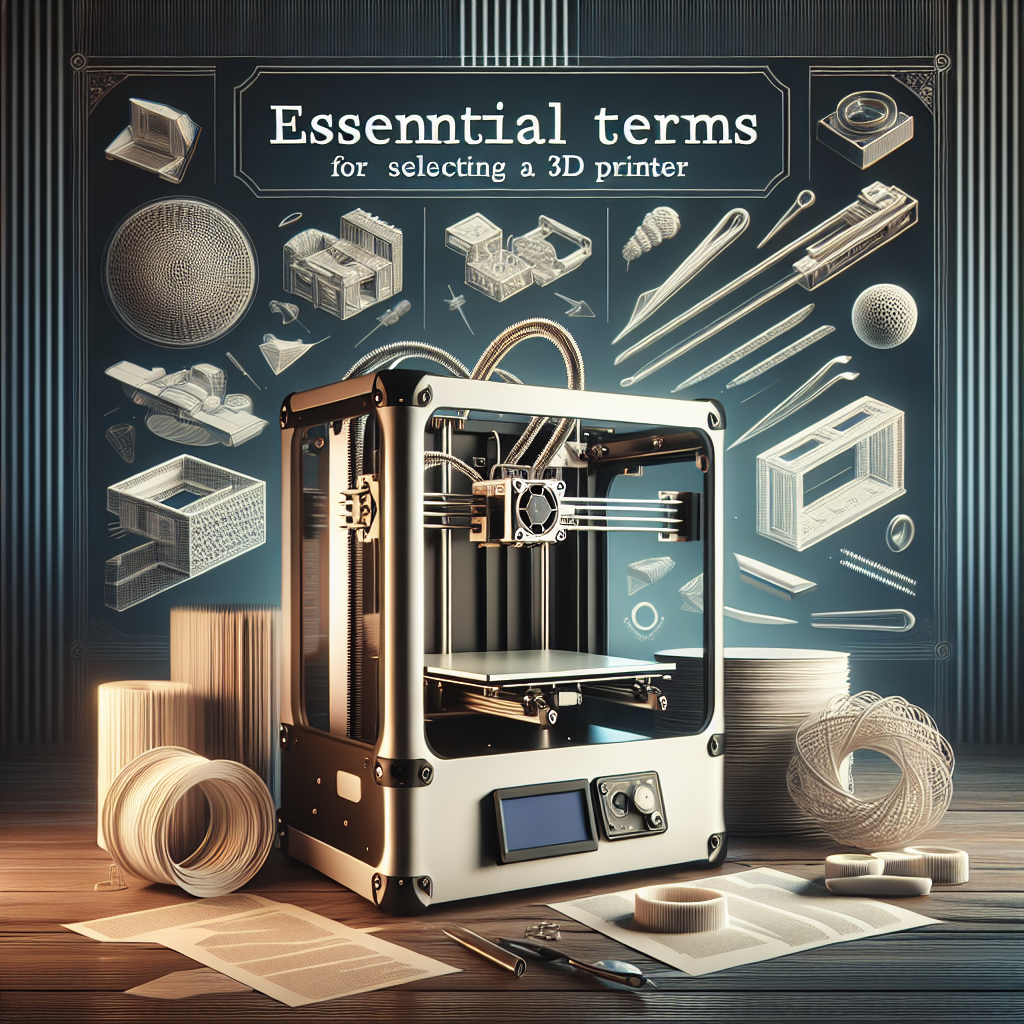When venturing into the world of 3D printing, selecting the right printer can be quite a daunting task. With numerous options available in the market, each boasting unique features and functionalities, understanding the terminology associated with 3D printers becomes essential. This guide aims to demystify key professional terms and provide insights into making an informed decision when choosing a 3D printer tailored to your specific needs.
Understanding 3D Printer Types
FDM (Fused Deposition Modeling)
FDM is one of the most common 3D printing technologies. It works by melting plastic filament and extruding it layer by layer to create a three-dimensional object. When considering an FDM printer, pay attention to the build volume, which refers to the maximum size of the object that can be produced. Additionally, look for user-friendly features like automatic bed leveling and an all-metal hot end for better temperature control.
SLA (Stereolithography)
SLA printers utilize a liquid resin that is cured by ultraviolet (UV) light. This method allows for high-resolution prints with impressive detail. However, SLA printing typically requires post-processing to remove excess resin and can have challenging material handling. For those focused on intricate designs, understanding the resin types and their properties—such as flexibility, strength, and durability—is crucial.
SLS (Selective Laser Sintering)
SLS technology uses a laser to fuse powdered material, usually nylon, into a solid structure layer by layer. One of SLS’s advantages is that it does not require support structures, making it perfect for complex geometries. Keep an eye on the type of materials supported by the printer and the cost associated with them, as SLS printing can become expensive due to the materials’ cost and the need for specialized equipment.
Key Printer Specifications to Review
Resolution
Resolution determines the detail level of your prints and is often measured in micrometers (microns). For instance, a 100-micron resolution produces finer details than a 200-micron resolution. Understanding your needs—whether you prioritize speed over detail or need high fidelity—will influence your chosen resolution and printer type.
Build Volume
The build volume of a 3D printer is its physical dimensions, indicating the maximum size of an object it can create. This specification is crucial, especially if you plan to print larger items or multiple smaller objects simultaneously. Evaluate space constraints and printing requirements to select a printer that fits.
Print Speed
Print speed refers to how fast a 3D printer can create an object, typically measured in millimeters per second (mm/s). While faster printers can save time, they might compromise quality. A balance between speed and quality is essential based on the intended use of the printed models.
Material Considerations
Filament Types
When choosing an FDM printer, consider the types of filament it can use. Common materials include:
- PLA (Polylactic Acid): A user-friendly choice ideal for beginners. It’s biodegradable and offers good detail but has lower temperature resistance.
- ABS (Acrylonitrile Butadiene Styrene): Stronger and more heat-resistant than PLA, but can emit fumes during printing.
- PETG (Polyethylene Terephthalate Glycol-Modified): A versatile filament combining the best of PLA and ABS. It’s durable, temperature-resistant, and easier to print.
Understanding the properties of different filaments will help ensure that your selected 3D printer can meet your material requirements.
Resin Options
For SLA printers, familiarize yourself with the types of resin available. Common options include standard resin for general prints and specialty resins—flexible or tough resins, for example—that serve specific purposes. Each resin type comes with unique handling and processing requirements, which should align with your printing needs.
Essential Features and Considerations
Heated Bed
A heated bed can significantly improve print adhesion, especially when working with thermoplastics like ABS. This feature minimizes warping in the initial layer and enhances overall print quality. Look for printers with adjustable temperature settings to accommodate various materials.
Automatic Bed Leveling
Having a printer with automatic bed leveling simplifies the setup process, ensuring that the print bed is level before starting a print. This feature is especially beneficial for beginners who might struggle with manual leveling.
Dual Extruder Capability
If the potential for multi-material prints interests you, consider a printer with dual extruders. This feature allows you to print with two different types of filament simultaneously, enabling multi-colored prints and even the use of water-soluble support materials for complex designs.
Software and Compatibility
Slicing Software
Slicing software translates your 3D design into instructions the printer can understand. Some printers come bundled with proprietary software, while others are compatible with third-party solutions like Cura or PrusaSlicer. Knowing the available software options can enhance your printing experience and expand creative possibilities.
File Formats
Familiarize yourself with the file formats that your printer supports. Common formats include STL (Stereolithography) and OBJ (Object File), which are widely used for 3D models. Ensuring compatibility with your 3D design software will streamline the printing process.
Community and Support
Online Communities
Join online communities like Reddit or Discord dedicated to 3D printing; they provide valuable insights, troubleshooting tips, and a support network. Engaging with fellow enthusiasts can help you navigate challenges and inspire new projects.
Customer Support
Select a manufacturer known for decent customer support. Accessible documentation, forums, and responsive assistance can be critical in resolving issues promptly and enhancing your 3D printing experience.
Conclusion
Choosing the right 3D printer necessitates a solid understanding of the various professional terms and specifications within the realm of additive manufacturing. By familiarizing yourself with the different types of printers, materials, features, and software options available, you can strategically select a machine tailored to your unique printing requirements. Whether you’re a hobbyist seeking to explore your creativity or a professional aiming for precision and efficiency, competence in this terminology empowers you to make an informed decision that aligns with your goals in the captivating world of 3D printing.
Daguang focuses on providing solutions such as precision CNC machining services (3-axis, 4-axis, 5-axis machining), CNC milling, 3D printing and rapid prototyping services.

















